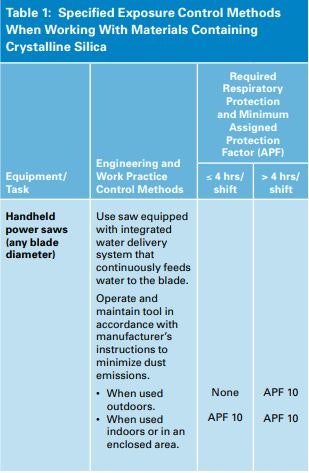
Silica dust has been recognized for decades as an occupational health concern. In March 2016, OSHA announced a final rule pertaining to silica exposure regulations. Enforcement for employers covered by the construction standard began in September 2017.
Made up of microscopic particles typically at least 100 times smaller than ordinary sand, silica dust is commonly found in materials associated with construction-related activities. Industries that deal with roads, buildings, sidewalks or landscaping materials—which require tasks that involve sawing, drilling or breaking silica-containing substances—are particularly prone to creating large amounts of it.
OSHA's final rule, which reduced the permissible exposure limit for crystalline silica to 50 micrograms per cubic meter of air (averaged over an eight-hour shift) requires employers to limit worker exposure via the use of engineering controls, work practices or respiratory protection.
With the identification of 18 common construction-related jobs, OSHA specifies exposure control methods to protect workers from crystalline silica in Table 1, focusing on equipment type and duration of the task at hand.
 Excerpt from OSHA’s Respirable Crystalline Silica Standard for Construction.OSHA
Excerpt from OSHA’s Respirable Crystalline Silica Standard for Construction.OSHA
Types of engineering controls for silica include wet methods and local exhaust ventilation, as well as process isolation. Work practice controls involve performing a task in a manner that prevents or reduces the likelihood or levels of exposure by decreasing the quantity of airborne dust. Administrative controls revolve around limiting time spent working with or in close proximity to the material.
In addition to instituting and executing a written, job-specitic exposure control plan that includes a description of housekeeping measures, OSHA's standard requires employers to train workers, limit access to high exposure areas and, in some cases, provide medical exams.
Numerous state agencies, universities and trade groups such as the Concrete Sawing and Drilling Association have also published articles in reference to the new rule, with information on topics such as dust control. OSHA, in an overview of the final rule, welcomes employers with “better ideas about how to provide protection” to incorporate alternate methods that “effectively reduce their workers’ exposure to silica dust.”
For multiple concrete contractors interviewed by Vacuworx, vacuum lifting systems have been identified as a viable alternative to drills and jack-hammers when lifting and handling concrete slabs.
Limiting the Number of Cuts
The use of walk-behind or handheld saws in enclosed areas is an example of one demolition-associated situation where protective measures need to be taken. OSHA states such saws should be equipped with an integrated water delivery system that continuously feeds water to the blade. In addition to this method, respiratory protection may be required — especially when cutting indoors, in enclosed areas or for an extended period of time.
In many cases, contractors commenting on their use of vacuum lifting equipment have reported the elimination of their need for dust-generating tools. With fewer saw cuts required since the concrete to be handled in larger pieces, adding vacuum lifting to the mix can help limit the amount of silica dust that would otherwise be released in the air. In addition, slabs can be removed with greater efficiency, which reduces the amount of time that workers may be exposed to environments in which silica dust is present.
Eliminating the Need for Hammers and Drills
According to the Centers for Disease Control and Prevention, jobs at risk for increased exposure to respirable crystalline silica include jackhammering, concrete drilling and sawing, demolition and mining, to name a few. In fact, researchers at the University of California found that silica dust generated by a pneumatic rock drill was at least 444 times greater than OSHA's permissible exposure limit. Furthermore, drilling can expose workers to hand vibration and noise at levels well above recommended limits.
Under OSHA's standard, wet methods may be needed to keep dust from getting into the air when using rotary drills, jackhammers or chipping tools. In some instances, tools should be equipped with a proper shroud and dust collection system. The fact that pieces of concrete can be chipped away while moving or loading must also be taken into account.
Vacuum lifting can be used as an alternative to anchors, shackles or hammers as concrete may be cut into larger, more uniform pieces that can be lifted out without the drilling, prying or breaking associated with conventional methods of removal. “The problem with hammering concrete is it goes into a million pieces,” says Dave Weston with Blade Runners. “The jackhammer causes too much dust, not to mention labor. Now they can keep it in one piece.”
Cutting Down on Clean Up
Water systems may be needed to help control the amount of silica dust created on jobsites. OSHA stipulates that slurry produced by wet cutting must be cleaned up to prevent it from drying and releasing silica dust into the air. Wet slurry is generally cleaned up using shovels or HEPA-filtered vacuum systems.
An added benefit to contractors who embrace vacuum lifting equipment is tidier working environments that result in fewer housekeeping chores. “By sawing concrete into bigger pieces, we’re saving on diamond blades, water usage and especially manual labor,” says Dave Desserault with Interstate Sawing & Drilling. “There is less cutting involved, which means less slurry removal. It's a lot quicker and a lot cleaner.”
It is estimated that 1 million construction workers are exposed to respirable crystalline silica dust. All contractors engaging in activities that fall under OSHA's silica rule are required to take measures to keep workers safe by reducing the quantity of hazardous dust they may inhale. Otherwise, they face the possibility of stiff penalties or costly fines for failing to comply.
The bottom line with the new rule is that OSHA expects to eventually prevent 600 deaths and over 900 cases of silicosis each year.
Sources:
https://www.cdc.gov/features/preventing-silicosis/index.html
https://www.osha.gov/silica/Tablelsect1926.1153.pdf



























